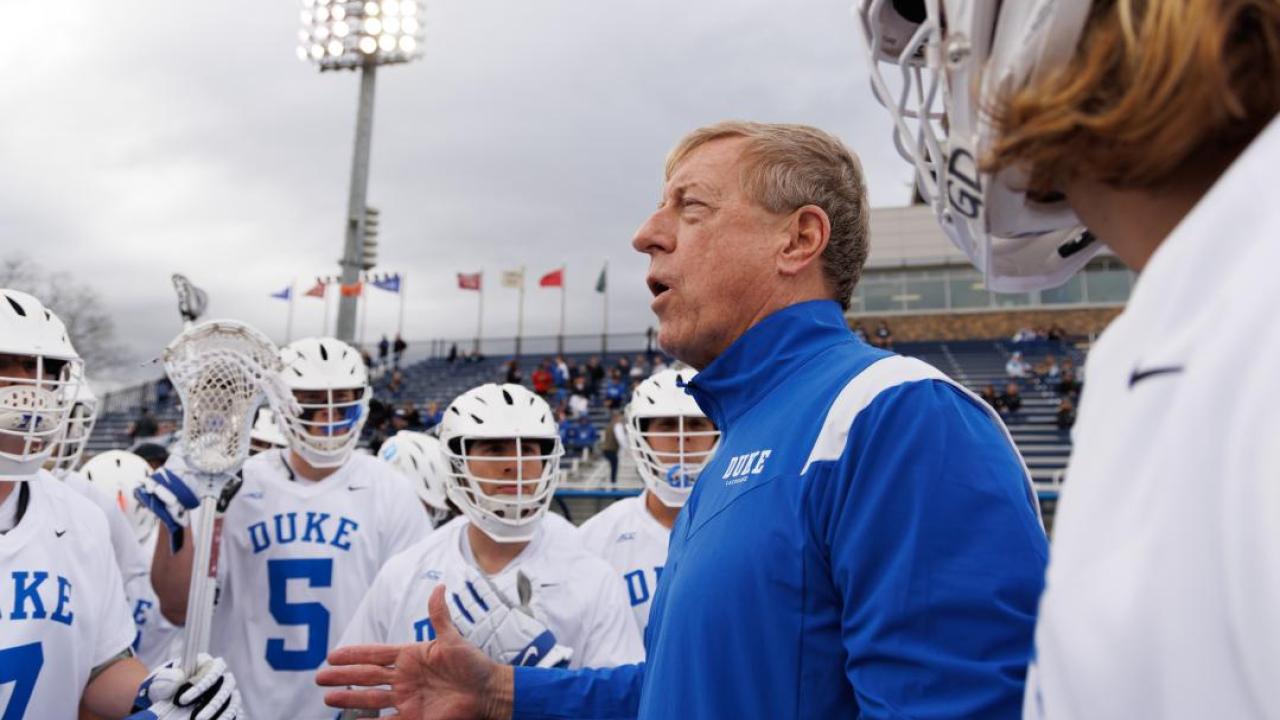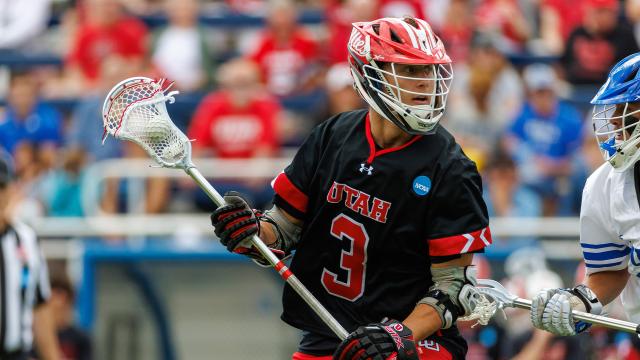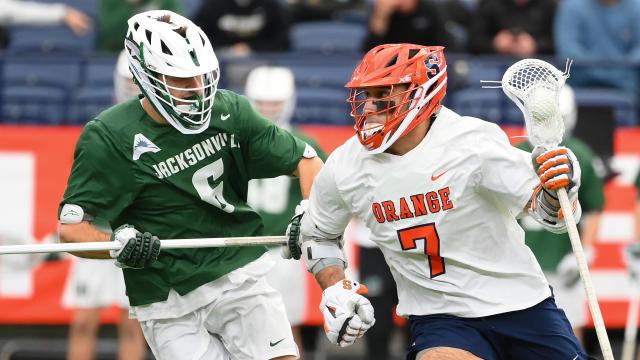
An A-to-Z Guide to Division I Men's Championship Weekend
What would the week leading into the final days of the college lacrosse season be without an alphabetic adventure?
One thing is for certain: It’s a lot different than last year. Championship weekend shifts out of New England after a two-year stop in East Hartford, Conn., and back into Philadelphia. An NFL stadium hosted the event every year from 2003-19 — and will again for at least the next four Memorial Day Weekends.
Then there are the teams: Duke, Notre Dame, Penn State and Virginia. None are foreign to the semifinals, but all of them fell short of this stage last year. It’s the first time since 2007 and only the second time in tournament history with a fresh set of semifinalists, year over year.
It means there is plenty to dive into while setting the stage for the last three games of the Division I season, starting with a league that is guaranteed to have a team playing on Monday afternoon …
A is for the ACC, which was limited to just one team in last year’s field and has produced three semifinalists this season in Duke, Notre Dame and Virginia. That group has stood above the rest of Division I nearly all season, combining to go 36-2 against everyone else. It is the fifth time the ACC has produced three semifinalists, including the second time in three years.
B is for Kenny Brower. A starter since his first game on campus, Brower anchors a defense that has allowed just 21 goals in three games this month. The defenseman, who regularly draws an opponent’s No. 1 matchup, is likely to be tasked with containing Penn State’s TJ Malone in Saturday’s first semifinal.
C is for the City of Brotherly Love, the championship weekend host for the eighth time since the format was adopted in 1986. Philadelphia was home to the 1992 final four (Franklin Field), and Lincoln Financial Field has welcomed the event in 2005-06, 2013, 2015-16 and 2019. Teams that earned titles at the facility include Johns Hopkins (2005), Virginia (2006 and 2019), Duke (2013), Denver (2015) and North Carolina (2016).
D is for Duke. The top-seeded Blue Devils (15-2) advanced to their 14th NCAA semifinal and fourth in the last five tournaments by edging Delaware in the first round before easing past Michigan in the quarterfinals. Duke has reached Memorial Day on six occasions and owns three national titles (2010, 2013 and 2014).
E is for Liam Entenmann, the four-year starter in the cage for Notre Dame and the latest in a long line of standout goalies for the Fighting Irish. Already named the ACC’s defensive player of the year, Entenmann is in contention to join Joey Kemp (2008) and John Kemp (2012) as national goalie of the year winners from Notre Dame.
F is for Jack Fracyon, the Penn State goalie who ranks fourth nationally in save percentage (57.2) and has arguably emerged as the Nittany Lions’ MVP this season. The sophomore has logged all but 13 minutes this season for Penn State, and he made at least 16 saves in five consecutive games prior to collecting 11 stops in a low-scoring quarterfinal defeat of Army.
G is for Peter Garno, a Virginia midfielder and a member of the Cavaliers’ extra-man unit. The fourth-year player, who often runs on the Cavaliers’ second midfield, had a season-high three points (two goals, on assist) to help Virginia get past Georgetown 17-14 in the quarterfinals last weekend.
H is for William Helm, Duke’s starting goalie by way of Division III St. Lawrence. The graduate student made 14 saves in the Blue Devils’ 15-8 quarterfinal triumph over Michigan and owns a 52.4 save percentage in his lone season in Division I.
I is for interdependence, and that pretty much sums up Virginia’s slick offense under the direction of assistant coach Sean Kirwan. The Cavaliers have recorded a school-record 187 assists (per the NCAA’s rankings), and their 11.69 assists per game vastly outpace the second-best average this season (Boston University at 9.0). Virginia sits 17 assists behind last year’s edition of Maryland for the most assists in a season in Division I history.
J is for Jersey, and the nearby Garden State is home to key contributors to each of the final four teams. Lehigh transfer Tommy Schelling plays on Duke’s extra-man unit; defenseman Kevin Parnham is Penn State’s most prominent New Jersey native; and defenseman Griffin Kology starts for Virginia. Notre Dame is getting the most mileage out of its Jersey ties, with defensemen Chris Conlin and Chris Fake and midfielder Brian Tevlin playing prominent roles.
K is for the Kavanagh brothers, siblings who play a major role in the Fighting Irish’s offensive success. Sophomore Chris Kavanagh has 10 hat tricks in 14 games this season, and has scored a team-high 43 goals. Senior Pat Kavanagh is a Tewaaraton Award finalist and is the best table-setter in the sport, with a school-record 50 assists to go with 23 goals. He is the only player in Notre Dame history with at least 38 assists in a season, and he’s done it three consecutive seasons.
L is for Petey LaSalla. With 1,753 career faceoffs taken, the Virginia fifth-year senior is the NCAA’s all-time leader in the category. And while the bonus COVID season certainly helped on that front, LaSalla is a fine example of the truism that the best ability is often availability. The rugged, durable LaSalla has taken all but 69 of Virginia’s faceoffs over 16 games. He’s also scored a career-high 11 goals in his final season.
M is for TJ Malone, the lone starter remaining in the program from Penn State’s 2019 final four team. After missing last season because of injury, the opportunistic Malone has emerged as an ideal top option for an offense short on star power but long on cohesion. Malone leads the Nittany Lions in both goals (33) and assists (32) and matched his season high with four goals in the quarterfinals against Army.
N is for Notre Dame. The third-seeded Fighting Irish (12-2) are in their sixth all-time NCAA semifinal and first since 2015 after clobbering Utah and smothering sixth-seeded Johns Hopkins in the first two rounds. Notre Dame has reached a pair of national title games (2010 and 2014) and is still seeking its first Division I title.
O is for Brennan O’Neill, the Duke junior and Tewaaraton finalist who heads into the season’s final weekend with 51 goals and 40 assists, joining Justin Guterding (2017 and 2018) as the only players in Blue Devils history with a 50/40 season. O’Neill collected six goals in the quarterfinals against Michigan to match a season-high set March 31 against Virginia.
P is for Penn State. The fifth-seeded Nittany Lions (11-4) came off back-to-back losing seasons to win the Big Ten regular season and are participating in their second NCAA semifinal after defeating Princeton and unseeded Army the last two weekends. Penn State, which lost in the semifinals in 2019 to Yale, is seeking its first national title in the sport.
Q is for Quint, a man who is almost universally known in lacrosse circles solely by his first name. Quint Kessenich has been a mainstay in the ESPN broadcast booth on championship weekend for nearly three decades. Two others with first names beginning with Q who bear mentioning: Notre Dame midfielder Quinn McCahon and Virginia defenseman Quentin Matsui.
R is for Alex Ross, the Penn State freshman defenseman who has started 12 of the Nittany Lions’ 15 games and leads the team in caused turnovers with 14. Ross and everyone else on the Penn State defense could have a little extra responsibility this weekend after senior Jack Posey departed Sunday’s quarterfinal defeat of Army with a right leg injury in the second quarter.
S is for Connor Shellenberger, the two-time Tewaaraton finalist who battled injuries throughout a largely inconsistent season. But forget the ups and downs of a year that included missing a game last month at North Carolina. Shellenberger is coming off a six-goal, four-assist blitz against Georgetown that saw him tie Virginia’s single-game postseason records for goals (which he already shared) and points. With 27 goals and 51 assists, he is the man orchestrating an attack that includes a pair of 50-goal scorers (Xander Dickson and Payton Cormier).
T is for the Traynor brothers, key pieces in Penn State’s offense. Jack, a fifth-year attackman, played in the 2019 semifinals against Yale and after a pair of injury-plagued seasons has delivered 31 goals and 16 assists. Matt, a sophomore, has enjoyed a breakout season, dropping 30 goals while emerging as one of the Big Ten’s (and Division I’s) best midfielders.
U is for uninvited, which describes how three of this year’s semifinalists felt last year on Selection Sunday. While Penn State (3-11) wasn’t eligible to be in the tournament thanks to a sub-.500 record, both Duke and Notre Dame were the most surprising exclusions in recent seasons. All three will attempt to join 1983 and 2008 Syracuse and 2012 Loyola as teams to win a title the year after missing the postseason.
V is for Virginia. The second-seeded Cavaliers (13-3) will participate in the NCAA semifinals for the 25th time (fourth-most all-time) and in the championship weekend format adopted in 1986 for the 18th time (tied with Maryland for the second most, behind only Syracuse). Virginia turned back Richmond and Georgetown to make it to the semis for the third time in four tournaments. The Cavaliers have played in 11 finals, winning an NCAA title on seven occasions (1972, 1999, 2003, 2006, 2011, 2019 and 2021).
W is for Dyson Williams, the Duke senior attackman who is three goals away from authoring the seventh 60-goal season in Blue Devils history. Williams, who had hat tricks against both Delaware and Michigan to open the tournament, could join Zack Greer (2007-08), Max Quinzani (2008 and 2010), Jordan Wolf (2014) and Justin Guterding (2018) in that select company this weekend.
X is for the X, or the dot, or whatever you want to call it. As ever, it bears monitoring as a potential bellwether for success. Duke ranks fifth in the country with a .609 faceoff percentage, while Virginia is 21st at .548. Both are far ahead of the other two teams, which come into the weekend under .500 on the season. Penn State (.462) ranks 51st, while Notre Dame (.455) is 56th among 75 Division I teams.
Y is for Yale, the original college home of a pair of impact transfers for Notre Dame. Defenseman Chris Fake started on a pair of final four teams while in New Haven, including a national title team as a freshman in 2018, and unsurprisingly was a valuable shut-down addition for the Irish as a graduate student. Joining him is do-everything midfielder Brian Tevlin, who takes shifts on offense, defense, faceoff wings and on man-down (the latter with a pole) and was also a key cog in Yale’s recent success.
Z is for Evan Zinn, part of Virginia’s lethal transition game as a defensive midfielder. Zinn, who began his career at Johns Hopkins and is in his second season with the Cavaliers, has nine goals and six assists on the year and has scored in five of Virginia’s last seven games. Between him, Noah Chizmar (eight goals, two assists) and Grayson Sallade (two goals, six assists), the Cavaliers are likely to generate some offense from their short sticks.
Patrick Stevens
Patrick Stevens has covered college sports for 25 years. His work also appears in The Washington Post, Blue Ribbon College Basketball Yearbook and other outlets. He's provided coverage of Division I men's lacrosse to USA Lacrosse Magazine since 2010.

Categories
Tags
Related Articles



